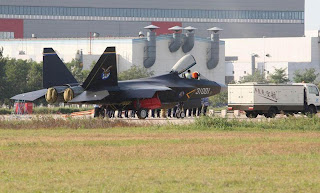China’s second stealth fighter jet, the J-31 Falcon Eagle, looks remarkably like earlier models of a twin-engine variant of the F-35 Joint Strike Fighter (JSF).
Last week’s maiden flight of the JSF’s Chinese doppelgänger comes less than two years after the inaugural flight of China’s first twin-engine J-20 Black Eagle stealth fighter, built by Chengdu Aircraft.
“The general design is reminiscent of the F-35, with edge alignment and Chinese associated with this generation of low-observable aircraft,” said Doug Barrie, senior fellow for military aerospace, at the U.K.-based International Institute for Strategic Studies. Reports of Chinese industrial espionage related to the JSF give this aircraft added interest, he said.
Built by Shenyang Aircraft, little is known of the Falcon Eagle’s true capabilities beyond analysis of the photos.
“The rear section of the Chinese aircraft, however, shows little LO [low observable] design, though this may reflect its developmental nature,” Barrie said. “Signature management is also about a great deal more than basic shaping, with materials technology and emission control in terms of radio frequency and infrared also significant. The extent or limit to which China has developed already the requisite technologies to address these areas remains an area of conjecture.”
Chinese-language media outlets indicate the fighter might serve on China’s future aircraft carrier fleet. China has one carrier-borne fighter in development, the Shenyang J-15 Flying Shark.
“I think it is plausible that the J-31 has been designed on the assumption that there will eventually be a carrier-based version, but I doubt if that is its raison d’etre,” said Roger Cliff, a China military specialist at the Project 2049 Institute in Washington.
“The double-wheel landing gear is suggestive, as are the large tail wings, but it has been pointed out that the J-31 might need a bigger main wing and other modifications before it can be considered optimized for a carrier role,” he said. The most important design factor is one analysts cannot yet see: the strength of the airframe.
“Carrier landings put tremendous stresses on the airframe that would tear apart an aircraft that was not designed for it,” Cliff said. “If the initial version of the J-31 has not been designed that way, then a new airframe design would be needed before it would be carrier-capable, double-wheel nose gear notwithstanding.”
This is one reason the J-15 Flying Shark has taken so long to develop, Cliff said. “It’s not just a matter of adding a tailhook and folding wings to a land-based aircraft.”
CHINESE F-60/J-21/J31 SHEN FEI FIFTH GENERATION STEALTH FIGHTER JET UNVEILED
 |
| Images are Courtesy of Tixue.net |


.jpg)



